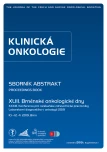Chemoembolization for Treatment of Hepatocellular Carcinoma – National Registry-Based Analysis
Authors:
T. Rohan 1,2
; T. Andrašina 1,2
; M. Uher 3,4; P. Matkulčík 2; J. Zavadil 1,2; M. Staňková 1,2; B. Čechová 2,5; L. Jandurová 2; V. Válek 1,2
Authors‘ workplace:
Klinika radiologie a nukleární medicíny LF MU a FN Brno
1; LF MU, Brno
2; Institut biostatistiky a analýz, LF MU, Brno
3; Ústav zdravotnických informací a statistiky ČR, Praha
4; CEITEC – Středoevropský technologický institut, Masarykova univerzita, Brno
5
Published in:
Klin Onkol 2019; 32(Supplementum1): 160-163
Category:
Article
Overview
Background: To evaluate survival benefit in patient undergoing transarterial chemoembolization (TACE) for hepatocellular carcinoma (HCC) by national registry data analysis and comparison of regions with unequal usage of interventional radiology procedures.
Materials and methods: A total of 4,343 patients with primary diagnosis of HCC between 2010–2016 were extracted from the databases of The Czech National Cancer Registry. The analysis was supported by data from the National Registry of Paid Health Services and the Death Records Database. Primary treatment option was categorized as liver resection, ablation, TACE and chemotherapy. The regional data analysis provided information of interventional radiology procedures frequency for primary treatment of HCC. The 14 main regions were symmetrically divided to group with well-developed interventional radiology service and low-developed interventional radiology service according the frequency of stage adjusted interventional radiology procedure usage (< 15%, > 15%). Kaplan-Meier and Cox regression were used for survival and hazard ratios (HR) analyses.
Results: Only 1,730 patients had assessed any primary treatment option, 16.5 % (285) were treated by TACE. Median of survival were significantly different in regions with well and low developed interventional radiology service for whole study population (13.2 vs. 6.5 months, p < 0.001), patients treated in regions with well-developed interventional radiology service had lower risk of death during treatment (HR 0.73; 0.66–0.81). The patient treated by TACE had median of survival 15.8 months (13.5–18.1), while the survival was not significantly different in region groups.
Conclusion: The usage of anticancer therapies based on interventional radiology procedures is a huge factor influences the survival of HCC patient according population-based data. Studies gathering data from cancer register databases can provide further information on treatment effectiveness.
This work was created at Masaryk University in the project „Oncological radiological interventions and their benefit in complex oncological treatment, comparison of dedicated oncological treatment results data of the Czech republic II“ (MUNI/A/1574/2018), supported by Ministry of Education, Youth and Sports.
This publication was additionally suported by Ministry of Health grant No. 15-32484A.
The authors declare they have no potential conflicts of interest concerning drugs, products, or services used in the study.
The Editorial Board declares that the manuscript met the ICMJE recommendation for biomedical papers.
Submitted: 1. 3. 2019
Accepted: 4. 3. 2019
Keywords:
hepatocellular carcinoma – Survival analysis – interventional radiology – transarterial chemoembolization
Sources
1. Akinyemiju T, Abera S, Ahmed M et al. The burden of primary liver cancer and underlying etiologies from 1990 to 2015 at the global, regional, and national level: results from the global burden of disease study 2015. JAMA Oncol 2017; 3 (12): 1683–1691. doi: 10.1001/jamaoncol.2017.3055.
2. SVOD. Český národní webový portál epidemiologie nádorů. [online]. Dostupné z: http: //svod.cz/.
3. Galle PR, Forner A, Llovet JM et al. EASL clinical practice guidelines: management of hepatocellular carcinoma. J Hepatol 2018; 69 (1): 182–236. doi: 10.1016/j.jhep.2018.03.019.
4. Trunecka P, Gerlei Z, Lisik W et al. Liver transplantation in Central Europe. Clin Exp Hepatol 2016; 2 (1): 21–26. doi: 10.5114/ceh.2016.58853.
5. Liu C, Duan L, Lu W et al. Prognosis evaluation in patients with hepatocellular carcinoma after hepatectomy: comparison of BCLC, TNM and Hangzhou criteria staging systems. PLoS One 2014; 9 (8): e103228. doi: 10.1371/journal.pone.0103228.
Labels
Paediatric clinical oncology Surgery Clinical oncologyArticle was published in
Clinical Oncology

2019 Issue Supplementum1
- Metamizole vs. Tramadol in Postoperative Analgesia
- Metamizole at a Glance and in Practice – Effective Non-Opioid Analgesic for All Ages
- Possibilities of Using Metamizole in the Treatment of Acute Primary Headaches
- Current Insights into the Antispasmodic and Analgesic Effects of Metamizole on the Gastrointestinal Tract
- Spasmolytic Effect of Metamizole
Most read in this issue
- Metastatic Clear Cell Renal Carcinoma Without Evidence of a Primary Renal Tumour Mimicking Advanced Stage of Malignant Lung Tumour
- Molecular Classification of Medullobastomas by Whole Genome Expression Profiling
- Dynamic Changes in Circulating MicroRNA Levels in Liver Cancer Patients Undergoing Thermal Ablation and Transarterial Chemoembolization
- Analysis of Blood Plasma MicroRNAs to Enable Identification of Patients with Pancreatic Ductal Adenocarcinoma Who Will Benefit from Surgical Resection
